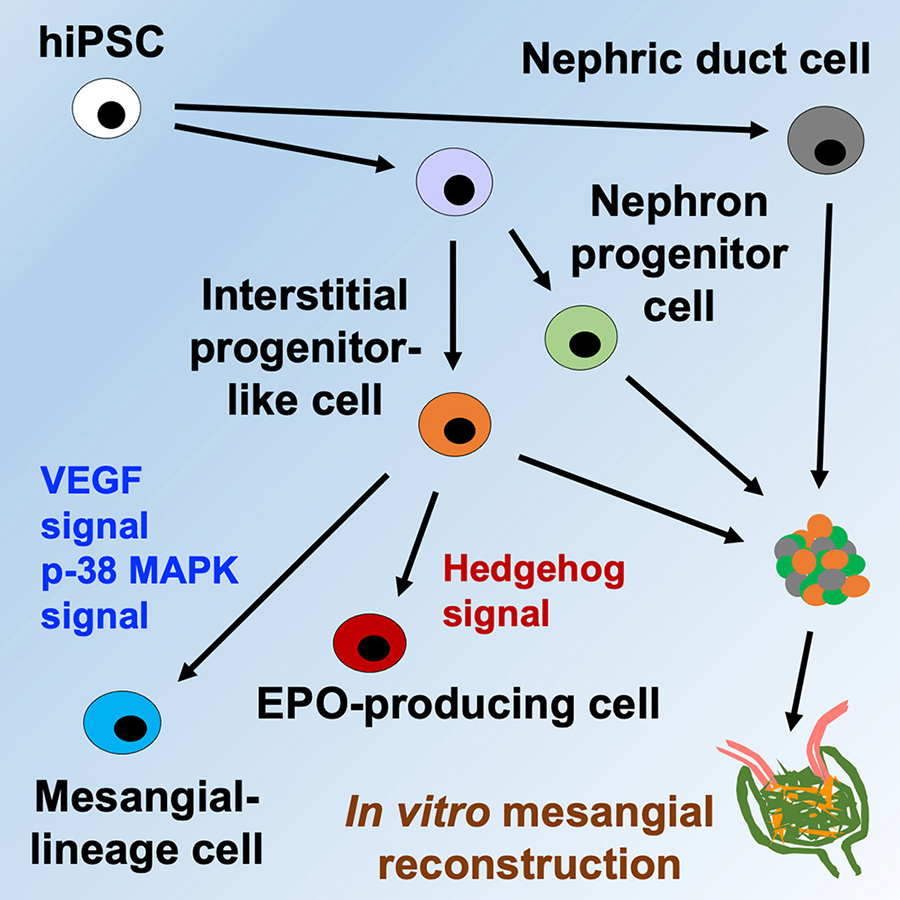
Research Activities
Research Activities
Publications
January 18, 2024
Learning from renal development to generate better kidney organoids for regenerative medicine
Main Points
- The kidney is primarily composed of three precursor cells. For the first time, the team has developed through this project a successful selective induction method for renal interstitial progenitor-like cells (IPLCs) from human induced pluripotent stem cells (hiPSCs).
- The glomerulus is the filtration unit of the kidney. By co-culturing IPLCs and other precursor cells, they have successfully created glomeruli with mesangium-like structures, which has not been achieved before in cell culture.
- Using IPLCs, they revealed essential signaling pathways involved in mesangial lineage and EPO-producing cell development.
- These findings, published this week in Cell Reports, will contribute to kidney regeneration and developmental research.
About 1 in 10 people worldwide are affected by renal diseases that greatly diminish kidney function. Despite advances in creating kidney cell types from human pluripotent stem cells, the lack of understanding in inducing specific cell types continues to hinder the development of therapeutic kidney tissues for treating kidney diseases and restoring renal function.
Among the three precursor cells of the kidney, there have been reports on selectively inducing differentiation of nephron progenitor cells and ureteric bud cells from hiPSCs. In research recently published in Cell Reports, the team described the development of a novel method for successful selective differentiation of the remaining IPLCs from hiPSCs. Kidneys eliminate waste products from the blood by excreting urine and contain glomeruli to filter the blood for this process. While glomeruli primarily originate from precursor cells called nephron progenitors, a functional unit known as mesangium arises from interstitial progenitors. By co-culturing IPLCs and hiPSC-derived nephron progenitor cells, they have successfully created an in vitro model of glomeruli with mesangium-like structures, which has not been achieved in a culture dish before. Furthermore, they have generated functionally relevant renal EPO-producing cells and mesangial lineage cells from IPLCs ex vivo and identified important signals necessary for their differentiation.
Together, these achievements contribute to new insights into the developmental biology of the human kidney, the elucidation of the mechanisms of kidney diseases, and research aimed at the development of regenerative medicine for renal diseases.

Graphical abstract
Quote from Each Party
-
Professor Kenji Osafune, CiRA
"The development of these kidney interstitial progenitor-like cells is the result of several years of intense work by our team. It has the potential to unlock new knowledge about the biology of kidney diseases that could be developed into novel therapies in the future." -
Rege Nephro
"Our collaboration with outstanding researchers at AstraZeneca and Kyoto University has been a driving force behind our innovation. We are focused on bringing this pioneering technology to practical use and developing potential new therapeutics for patients with kidney disease." -
Dr. Kevin Woollard, AstraZeneca
"Knowledge of human kidney development is vital to understand the mechanisms associated with kidney diseases and support effective drug development programs. We were delighted to be part of this collaborative study to capture new science around the differentiation of renal stem cell lineages and kidney cell structures."
Paper Details
- Journal: Cell Reports
- Title: Selective induction of human renal interstitial progenitor-like cell lineages from iPSCs reveals development of mesangial and EPO-producing cells
- Authors:
Hiraku Tsujimoto1,2, Azusa Hoshina1, Shin-Ichi Mae1, Toshikazu Araoka1, Changting Wang1, Yoshihiro Ijiri1, May Nakajima-Koyama1, Satoko Sakurai1, Kazusa Okita1, Ken Mizuta3, Akira Niwa1, Megumu K Saito1, Mitinori Saitou1,3,4, Takuya Yamamoto1,4,5, Cecilia Graneli6, Kevin J Woollard6 and Kenji Osafune1*
*: Corresponding author - Author Affiliations:
- Center for iPS Cell Research and Application (CiRA), Kyoto University.
- Rege Nephro Co., Ltd.
- Graduate School of Medicine, Kyoto University.
- Institute for the Advanced Study of Human Biology (WPI-ASHBi), Kyoto University.
- Medical-risk Avoidance based on iPS Cells Team, RIKEN Center for Advanced Intelligence Project (AIP).
- AstraZeneca PLC.






















